Gahnia grandis
| Gahnia grandis | |
|---|---|
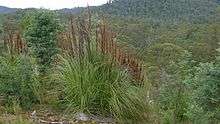 | |
| Scientific classification | |
| Kingdom: | Plantae |
| (unranked): | Angiosperms |
| Phylum: | Tracheophyta |
| (unranked): | Monocots |
| Class: | Magnoliopsid |
| (unranked): | Commelinids |
| Order: | Poales |
| Family: | Cyperaceae |
| Genus: | Gahnia |
| Species: | G. grandis |
| Binomial name | |
| Gahnia grandis (Labill.) S.T.Blake. | |
| Synonyms | |
|
Scleria grandis Labill. | |
Gahnia grandis is a tussock forming perennial plant found in southeastern Australia and Tasmania.
Originally described by botanist Jacques Labillardière as Scleria grandis in 1800,[1] it was placed in its current genus by S. T. Blake in 1969.[2] In Tasmania widely commonly perceptible genus is Gahnia with other seven native species. Six of these species are very large, erect graminoids with razor-like, sharp-edged leaves hence the common name of cutting grass.
Description
Gahnia grandis is an easily identifiable tussock and perennial herb, widespread throughout Tasmania. Cutting grass is a tall (1-3 x 2-3m), robust and tussock-forming sedge. The flowering stems are stout, often sprawling before becoming erect. The leaves are flat, sheathing, and channeled to 2.5m long, narrow, spiral shape of stem, margins are sharp, and the sheaths are brown. The inflorescences are emergent from a long tangled stem with weeping leaves. The stems (culms) are stout, 1-3 m high and about 2-10 mm in diameter and often sprawl from base for 1-2m.
Sometimes flowers can be drooping with spikes 50-100 cm long, often 1-sided, lower side with presences of bracts much shorter than upper. The flower-heads are panicle-like in shape. The flowers are in spikelets, with each spikelet 2-flowered where upper flower is bisexual while the lower flower is sterile or male. The lowest glumes are in 8-12 number which are much shorter compare to above and also irregularly toothed at erose also called margin which is brown to dark grey-brown in color and in color and in texture to touch is slightly rough. The glumes at the upper part of the plant have a pointed to bluntly rounded apex. The cream colored flowers possess 4-5 stamens with 2-3 mm long anthers. The seeds resemble a nut and are oblong to narrow with oval in shape have smooth which is about 3.0-4.5 mm long, 1.2-1.9 mm in diameter and reddish dark brown to orange brown in color.
Habitat and distribution
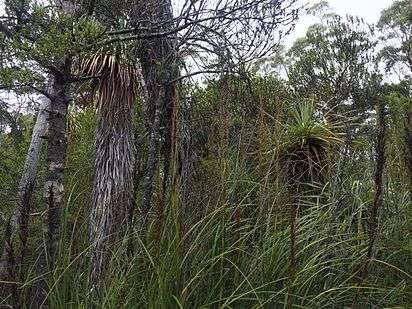
Origin of Gahnia grandis was from Southern Australia. Gahnia is a very commonly observed species in Tasmania. Seven species are native in Tasmania. Such species are very commonly found in wet forest and more frequently observed especially after fire. Such species are also observed on coastal areas and sometimes in dry woodland. G. rodwayi which is small resembles to grass like herb of dry forests in South-east of Tasmania. Generally the flowering time of this species is during October to January. This species grows in moist soil besides water streams in gullies of shady forest and dappled to semi shade. About 40 species are found in Australia region, Asia and the Pacific Islands.[4]
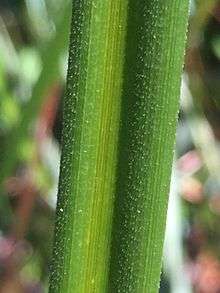
Western Australia, Queensland, New South Wales, Victoria and Tasmania are hot spots in regards to the species .The Bioregion such as Gippsland plain, Wilsons Promontory and Highlands-Southern Fall have occurrence states of this species as present with native establishment.From past records in Victoria it is found only at two possible sites one is Gembrook-Beenak area and second the northern part of Wilsons promontory.[5]
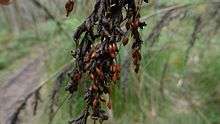
In Tasmania Gahnia grandis is commonly widespread in all regions except the midlands and the northeast, which are poorly drained soil type from sea-level to the mountain. It can also be found on margins of wetlands, within riparian areas and button grass heaths, on margins of forest and along the road cuttings and ditches.
Uses and application
Cutting grass has been traditionally used by indigenous people and Aboriginal Islander in basket weaving, rope making. The nuts were pounded and ground into flour for making of bread while young bases can be eaten from plants growing in wetter locations. The seed heads provide an attractive contrast in ornaments and decorative items. Gahnia species are very useful and can be used in many different aspects. This species can be used for bid attracting and butterfly attracting.It provides safe habitat for nesting for birds, butterfly, caterpillar and other small insects and animals. It is habitat of threatened species like Eastern barred bandicoots which have distinctive stripes on its back.[6]During late 2007 ,with the support funding from the world wildlife fund, the Hobart city council, Threatened Species Network and parks and other wildlife service’s held various kinds of workshops and awareness program for saving one of the most special animals ‘Eastern barred bandicoots’ by saving vegetation of Gahnia grandis.
Gahnia grandis is tolerant of damp soils, drought, full sun or shade and moderate frost 25F [-4 C] so it can be utilized in various locations. It is also planted to improve soil fertility because Gahnia grandis help in stopping of soil erosion. [7]
This species can be planted on the sides of roads and in surrounding of farm land as natural protective boundaries from marsupial, natural habitat for insects. After drying of it can be used as fire fuel. It can be also utilized in manufacturing wooden art crafts, wooden furniture, baskets, ornaments, decorative art works and furniture items. It can be used as in freshly decorative in flower pots which gives nice ambiance to any place. It can be planted in home gardens and backyard as an ornamental species. I
Confusing species
Many of the other Gahnia species are similar to Gahnia grandis and are also referred to as cutting grass, but they can be differentiated by seed heads structure and floral parts.
Ecology
Cutting grass is very hard perennial grass species with woody rhizomes which forms very big tussocks. Most of the year it is usually found in moist soil and often subject to periodic inundation. Once it’s established cutting grass can tolerate dry climatic conditions and windy situations. The flowering season of cutting grass is from spring through summer. The maturity of seeds can be predicted by its color of flower head, bright brown color of fruit indicates immature fruit while turning black at maturity and ready to use in food preparation.
Number of species of cyperace family including cutting grass are considered as important food sources and safe habitat for native birds, insects such as currawong, native moths and butterflies such as choastola skipper and its scientific name is Antipoda choatola leucophaea. During night choastola skipper feeds on Gahnia radula and plays vital role in pollination and many other insects also feeds exclusively on Gahnia species.
Cutting grass solely dependent on birds such as the currawong for seed dispersal and germination. This birds eats red flashy fruits then regurgitates the partially digested hard inner nut on ground, in this manner it plays important role for seed dispersal. Based on one hypothesis bird’s stomach acid weakens tough seed coat which allows easier germination. Cutting grass also considered as ideal habitat for rare and threatened burnie burrowing crayfish (Engaeus yabbimunna). Cutting grass is resistant to phytophthora cinnamomi but highly flammable.
Perspective for cultivation
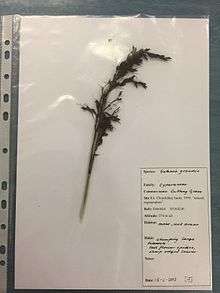
There is low potential for cultivation of cutting grass because this plant is probably not highly desirable for horticulture due to its sharp cutting long leaves and untidy appearance. However it’s a brilliant species for rehabilitation and vegetation regrowth due to its hardiness and soil holding properties which helps in prevention of soil erosion.
Generally, Gahnia species can be proven difficult in regards to propagation. The best way to propagate cutting grass is by germination of seeds, due to limitations with division and transplantation of species. Due to seed dormancy, the seed will germinate after 12 months it’s collected. The easy way to collet seeds is by chopping off the seed-heads off from base with a pair of secateurs. To extract best seeds is by placing seed heads on groundsheet and let them dry thoroughly for few days. To dislodge seed thrashing may be needed. Dry storing is advised to conserve seeds for longer shelf life.
References
- ↑ "Scleria grandis Labill.". Australian Plant Name Index (APNI), IBIS database. Centre for Plant Biodiversity Research, Australian Government.
- ↑ "Gahnia grandis (Labill.) S.T.Blake.". Australian Plant Name Index (APNI), IBIS database. Centre for Plant Biodiversity Research, Australian Government.
- ↑ "Gahnia grandis". Australianplants.com. 2017. Retrieved March 25, 2017.
Australian Native Plants • Plants • 800.701.6517.
- ↑ "Flora of Victoria". Vicflora.rbg.vic.gov.au.
- ↑ "Gahnia grandis. (2017). 1st ed.". Tasmania: Tasmania government, pp.3-3.
- ↑ ""Backyard Bandicoots - About The Eastern Barred Bandicoot".". Hobartcity.com.au. N.p., 2017. Web. 25 Mar. 2017.
- ↑ "Australianplants.com. (2017). Gahnia grandis". Australian Native Plants • Plants • 800.701.6517.
- ↑ "Gahnia Grandis. (2017). 1st ed." (PDF). Tasmania: Tasmania government, pp.3-3.
- ↑ "Gahnia Grandis. (2017). 1st ed." (PDF). Tasmania: Tasmania government, pp.3-3.